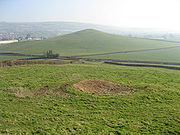
Q-pit
Encyclopedia

White coal
White coal is a form of fuel produced by drying chopped wood over a fire. It differs from charcoal which is carbonised wood. White coal was used in England to smelt lead ore from the mid-sixteenth to the late seventeenth centuries. It produces more heat than green wood but less than charcoal and...
prior to the Industrial Revolution
Industrial Revolution
The Industrial Revolution was a period from the 18th to the 19th century where major changes in agriculture, manufacturing, mining, transportation, and technology had a profound effect on the social, economic and cultural conditions of the times...
when white coal was largely superseded by the use of coke
Coke (fuel)
Coke is the solid carbonaceous material derived from destructive distillation of low-ash, low-sulfur bituminous coal. Cokes from coal are grey, hard, and porous. While coke can be formed naturally, the commonly used form is man-made.- History :...
.
Purpose
White coal produced in Q-pits was largely used in the smelting of lead from about 1550 to 1750, when a process was discovered that used coal. The large sections of white coal had previously been mixed with charcoal to give the right temperature, as charcoal alone was too hot and would have volatilised the lead. Some evidence exists to suggest that some had a secondary use in the charking of coal into coke.Location
Many Q-pits were located in deciduousDeciduous
Deciduous means "falling off at maturity" or "tending to fall off", and is typically used in reference to trees or shrubs that lose their leaves seasonally, and to the shedding of other plant structures such as petals after flowering or fruit when ripe...
woodlands and as such they are an important landscape feature indicating both previous industrial activity and the presence of a wood at the site or nearby. They are often found in association with saw pit
Saw pit
A saw pit or sawpit is a pit over which lumber is positioned to be sawed with a long two-handled saw by two men, one standing above the timber and the other below. It was used for producing sawn planks from tree trunks, which could then be cut down into boards, pales, posts, etc. Many towns,...
s.
Construction
The pits were created by moving soil to create a depression about 12-13 feet (C.4m) across which was breached by a 'spout' and thus forming a 'Q' shape. The pits were dug from the end of the Middle AgesMiddle Ages
The Middle Ages is a periodization of European history from the 5th century to the 15th century. The Middle Ages follows the fall of the Western Roman Empire in 476 and precedes the Early Modern Era. It is the middle period of a three-period division of Western history: Classic, Medieval and Modern...
up to around 1760, the start of the Industrial Revolution.
Geographical location
They are a common feature in lead mining districts such as the LeadhillsLeadhills
Leadhills is a village in South Lanarkshire, Scotland, 5¾ miles WSW of Elvanfoot. Population 835. Originally known as Waterhead, It is the second highest village in Scotland after Wanlockhead, lying 395m above sea-level, near the source of Glengonnar Water, an affluent of the River Clyde...
in Scotland and East Derbyshire. Due to their small size are not likely to be confused with quarries, although bomb craters from WW2 can occasionally lead the landscape historian astray.
In 2007 an isolated example was identified and excavated in Westbury-sub-Mendip
Westbury-sub-Mendip
Westbury-sub-Mendip is a village in Somerset, England, with a population of about 800, situated on the southern slopes of the Mendip Hills from Wells and Cheddar.The parish boundary is formed by the River Axe-History:...
not far from the lead smelting areas on the Mendip Hills
Mendip Hills
The Mendip Hills is a range of limestone hills to the south of Bristol and Bath in Somerset, England. Running east to west between Weston-super-Mare and Frome, the hills overlook the Somerset Levels to the south and the Avon Valley to the north...
in Somerset. Over 200 have been surveyed in Ecclesall Woods
Ecclesall Woods
Ecclesall Woods is an area of woodland in south-west Sheffield, South Yorkshire, England, between Abbeydale Road South and Ecclesall. It covers approximately of mature semi-natural deciduous woodland which was previously used for timber and charcoal, and is currently managed by the city council...
, Sheffield.

